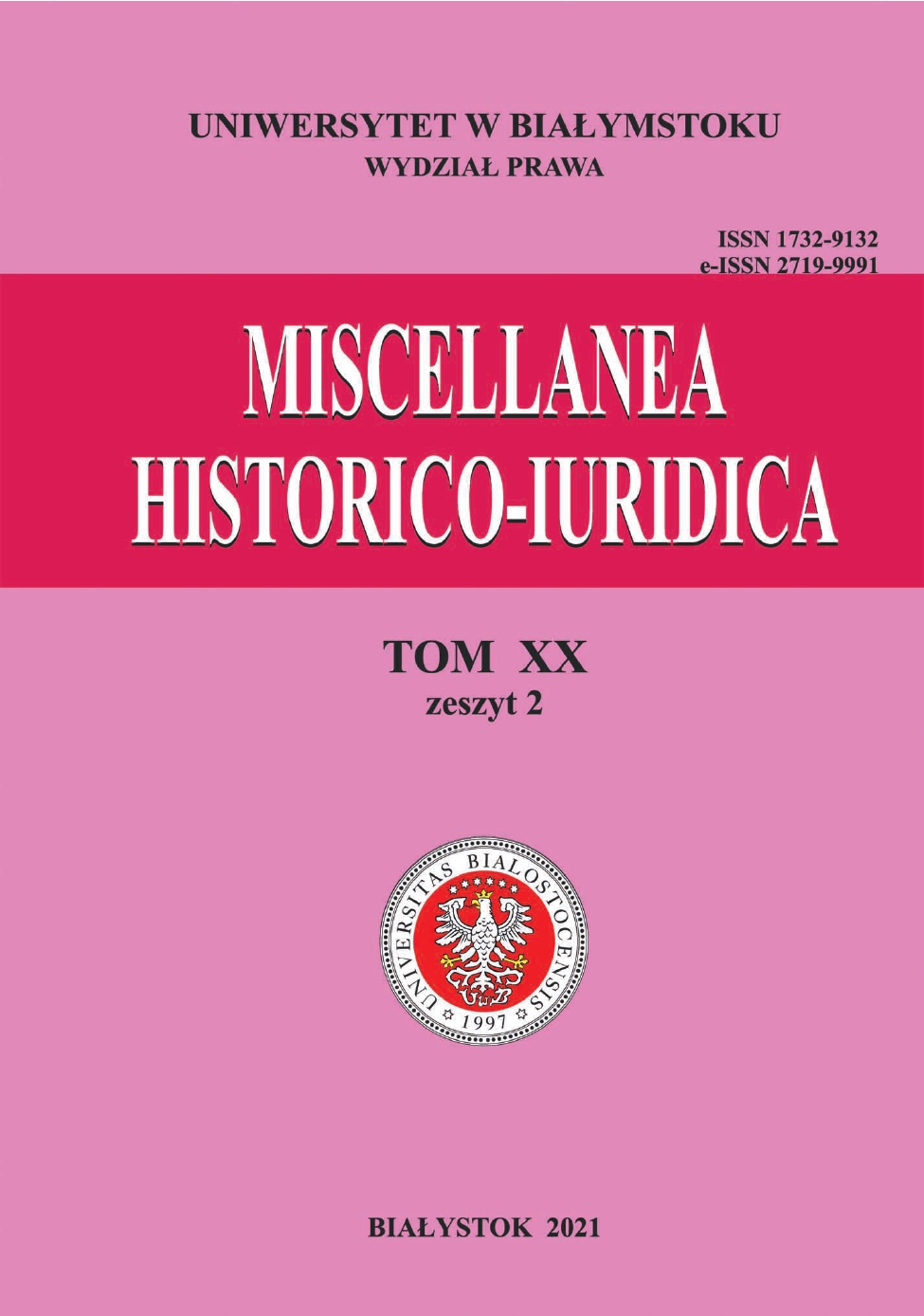Powstanie i kulisy uchwalenia ustawy przechodniej z dnia 18 maja 1921 r. do Ustawy Konstytucyjnej z dnia 17 marca 1921 r. w sprawie czasowej organizacji władzy zwierzchniej Rzeczypospolitej
Słowa kluczowe:
ustawa przechodnia, konstytucja marcowa 1921, Komisja KonstytucyjnaAbstrakt
10 lutego 1919 r. na pierwsze posiedzenie zebrał się Sejm Ustawodawczy, którego głównym celem było przygotowanie projektu ustawy zasadniczej dla odrodzonej Polski. Przez najbliższe miesiące, w specjalnie utworzonej do tego celu Komisji Konstytucyjnej, pracowano nad utworzeniem i przedstawieniem Sejmowi Ustawodawczemu projektu nowej konstytucji. W celu jednak zapewnienia choćby podstawowych ram funkcjonowania państwa już 20 lutego 1919 r. podjęto uchwałę Sejmu Ustawodawczego w sprawie powierzenia Józefowi Piłsudskiemu dalszego sprawowania urzędu Naczelnika Państwa. Uchwała ta, potocznie zwana małą konstytucją, obowiązywała formalnie do 1 czerwca 1921 r., czyli dnia ogłoszenia konstytucji marcowej. Mimo formalnego uchylenia tychże przepisów, funkcjonowały one nadal. W stosunku do Sejmu Ustawodawczego przepisy Małej Konstytucji obowiązywały do 28 listopada 1922 r., zaś w stosunku do Naczelnika Państwa do 14 grudnia 1922 r. Z uwagi jednak na zauważenie błędu legislacyjnego w małej konstytucji oraz w przepisach przechodnich w konstytucji marcowej uchwalono 18 maja 1921 r. ustawę przechodnią do Ustawy Konstytucyjnej z dnia 17 marca 1921 r. w sprawie tymczasowej organizacji władzy zwierzchniej Rzeczypospolitej, która „załatała” błędnie sformułowane przepisy w małej konstytucji. Praca została oparta na literaturze poświęconej ustawie zasadniczej z 1921 r., projektach ustaw oraz poprawkach przedstawionych w Komisji Konstytucyjnej, a także na licznych stenogramach z posiedzenia Sejmu Ustawodawczego, Sejmu Rzeczypospolitej Polskiej oraz Zgromadzenia Narodowego.
Bibliografia
Józef Piłsudski: Pisma zbiorowe, Instytut Józefa Piłsudskiego, t. 5, Warszawa 1937.
Komarnicki W., Ustrój państwowy Polski współczesnej: geneza i system, Wilno 1937.
Krukowski S., Geneza konstytucji z 17 marca 1921 r., Warszawa 1977.
Krukowski S., Konstytucja Rzeczypospolitej Polskie z 1921 r., [w:] Konstytucje Polski. Studia monograficzne z dziejów polskiego konstytucjonalizmu, pr. zbiór. pod red. M. Kallas, t. 2, Warszawa 1990.
Pobóg-Malinowski W., Najnowsza historia polityczna Polski 1914–1939, t. 2, Gdańsk 1990.
Projekt ustawy przechodniej do ustawy konstytucyjnej w przedmiocie tymczasowej organizacji władzy zwierzchniej w Rzeczypospolitej (Druk nr 2703).
Protokół Zgromadzenia Narodowego dla wyboru Prezydenta Rzeczypospolitej Polskiej z dnia 9 grudnia 1922 r.
Protokół Zgromadzenia Narodowego z zaprzysiężenia nowowybranego Prezydenta Rzeczypospolitej Polskiej Gabryela Narutowicza z dnia 11 grudnia 1922 r.
Próchnik A., Pierwsze piętnastolecie Polski niepodległej [1918–1933]: zarys dziejów politycznych, Warszawa 1933.
Sprawozdanie komisji konstytucyjnej w sprawie tymczasowej organizacji władzy zwierzchniej Rzeczypospolitej. Ustawa przechodnia do ustawy o Konstytucji Rzeczypospolitej Polskiej (Druk nr 2706).
Sprawozdanie stenograficzne z 1. Posiedzenia Sejmu Rzeczypospolitej z dnia 28 listopada 1922 r.
Sprawozdanie stenograficzne z 1. Posiedzenia Sejmu Ustawodawczego z dnia 10 lutego 1919 r.
Sprawozdanie stenograficzne z 2. Posiedzenia Sejmu Rzeczypospolitej z dnia 1 grudnia 1922 r.
Sprawozdanie stenograficzne z 221. Posiedzenia Sejmu Ustawodawczego z dnia 17 marca 1921 r.
Sprawozdanie stenograficzne z 227. Posiedzenia Sejmu Ustawodawczego z dnia 18 maja 1921 r.
Sprawozdanie stenograficzne z 3. Posiedzenia Sejmu Rzeczypospolitej z dnia 2 grudnia 1922 r.
Sprawozdanie stenograficzne z 341. Posiedzenia Sejmu Ustawodawczego z dnia 27 listopada 1922 r.
Uchwała Sejmu z dnia 20 lutego 1919 r. o powierzeniu Józefowi Piłsudskiemu dalszego sprawowania urzędu Naczelnika Państwa (Dz.Pr.P.P. 1919 nr 19, poz. 226).
Ustawa przechodnia z dnia 18 maja 1921 r. do Ustawy Konstytucyjnej z dnia 17 marca 1921 r. w sprawie czasowej organizacji władzy zwierzchniej Rzeczypospolitej (Dz.U. 1921 nr 44, poz. 268).
Ustawa z dnia 17 marca 1921 r. - Konstytucja Rzeczypospolitej Polskiej (Dz.U. 1921 nr 44, poz. 267).
Ustawa z dnia 26 września 1922 r. o zasadach powszechnego samorządu wojewódzkiego, a w szczególności województwa lwowskiego, tarnopolskiego i stanisławowskiego (Dz.U. 1922 nr 90, poz. 829).
Ustawa z dnia 28 lipca 1922 r. - Ordynacja wyborcza do Sejmu (Dz.U. 1922 nr 66, poz. 590).
Ustawa z dnia 28 lipca 1922 r. - Ordynacja wyborcza do Senatu (Dz.U. 1922 nr 66, poz. 591).
Ustawa z dnia 8 kwietnia 1919 r. o nietykalności członków Sejmu Ustawodawczego (Dz.Pr.P.P. 1919 nr 31, poz. 263).
Pobrania
Opublikowane
Numer
Dział
Licencja
Prawa autorskie (c) 2021 Uniwersytet w Białymstoku (zeszyt jako całość); Michał Paweł Stokowski (artykuł)

Utwór dostępny jest na licencji Creative Commons Uznanie autorstwa – Na tych samych warunkach 4.0 Miedzynarodowe.







